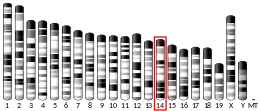MTMR9
Myotubularin-related protein 9 is a protein that in humans is encoded by the MTMR9 gene.[5][6][7][8]
| MTMR9 | |||||||||||||||||||||||||||||||||||||||||||||||||||
|---|---|---|---|---|---|---|---|---|---|---|---|---|---|---|---|---|---|---|---|---|---|---|---|---|---|---|---|---|---|---|---|---|---|---|---|---|---|---|---|---|---|---|---|---|---|---|---|---|---|---|---|
| Identifiers | |||||||||||||||||||||||||||||||||||||||||||||||||||
| Aliases | MTMR9, C8orf9, LIP-STYX, MTMR8, myotubularin related protein 9 | ||||||||||||||||||||||||||||||||||||||||||||||||||
| External IDs | OMIM: 606260 MGI: 2442842 HomoloGene: 9148 GeneCards: MTMR9 | ||||||||||||||||||||||||||||||||||||||||||||||||||
| |||||||||||||||||||||||||||||||||||||||||||||||||||
| |||||||||||||||||||||||||||||||||||||||||||||||||||
| |||||||||||||||||||||||||||||||||||||||||||||||||||
| |||||||||||||||||||||||||||||||||||||||||||||||||||
| |||||||||||||||||||||||||||||||||||||||||||||||||||
| Wikidata | |||||||||||||||||||||||||||||||||||||||||||||||||||
| |||||||||||||||||||||||||||||||||||||||||||||||||||
Function
This gene encodes a myotubularin-related protein that is atypical to most other members of the myotubularin-related protein family because it has no dual-specificity phosphatase domain. The encoded protein contains a double-helical motif similar to the SET interaction domain, which is thought to have a role in the control of cell proliferation. In mouse, a protein similar to the encoded protein binds with MTMR7, and together they dephosphorylate phosphatidylinositol 3-phosphate and inositol 1,3-bisphosphate.[8]
References
- ENSG00000285032 GRCh38: Ensembl release 89: ENSG00000104643, ENSG00000285032 - Ensembl, May 2017
- GRCm38: Ensembl release 89: ENSMUSG00000035078 - Ensembl, May 2017
- "Human PubMed Reference:". National Center for Biotechnology Information, U.S. National Library of Medicine.
- "Mouse PubMed Reference:". National Center for Biotechnology Information, U.S. National Library of Medicine.
- Appel S, Reichwald K, Zimmermann W, Reis A, Rosenthal A, Hennies HC (Jul 2001). "Identification and localization of a new human myotubularin-related protein gene, mtmr8, on 8p22-p23". Genomics. 75 (1–3): 6–8. doi:10.1006/geno.2001.6591. PMID 11472061.
- Appel S, Filter M, Reis A, Hennies HC, Bergheim A, Ogilvie E, Arndt S, Simmons A, Lovett M, Hide W, Ramsay M, Reichwald K, Zimmermann W, Rosenthal A (Mar 2002). "Physical and transcriptional map of the critical region for keratolytic winter erythema (KWE) on chromosome 8p22-p23 between D8S550 and D8S1759". Eur. J. Hum. Genet. 10 (1): 17–25. doi:10.1038/sj.ejhg.5200750. PMID 11896452.
- Mochizuki Y, Majerus PW (Aug 2003). "Characterization of myotubularin-related protein 7 and its binding partner, myotubularin-related protein 9". Proc. Natl. Acad. Sci. U.S.A. 100 (17): 9768–73. Bibcode:2003PNAS..100.9768M. doi:10.1073/pnas.1333958100. PMC 187840. PMID 12890864.
- "Entrez Gene: MTMR9 myotubularin related protein 9".
Further reading
- Maruyama K, Sugano S (1994). "Oligo-capping: a simple method to replace the cap structure of eukaryotic mRNAs with oligoribonucleotides". Gene. 138 (1–2): 171–4. doi:10.1016/0378-1119(94)90802-8. PMID 8125298.
- Andersson B, Wentland MA, Ricafrente JY, Liu W, Gibbs RA (1996). "A "double adaptor" method for improved shotgun library construction". Anal. Biochem. 236 (1): 107–13. doi:10.1006/abio.1996.0138. PMID 8619474.
- Yu W, Andersson B, Worley KC, Muzny DM, Ding Y, Liu W, Ricafrente JY, Wentland MA, Lennon G, Gibbs RA (1997). "Large-scale concatenation cDNA sequencing". Genome Res. 7 (4): 353–8. doi:10.1101/gr.7.4.353. PMC 139146. PMID 9110174.
- Suzuki Y, Yoshitomo-Nakagawa K, Maruyama K, Suyama A, Sugano S (1997). "Construction and characterization of a full length-enriched and a 5'-end-enriched cDNA library". Gene. 200 (1–2): 149–56. doi:10.1016/S0378-1119(97)00411-3. PMID 9373149.
- Wang JC, Radford DM, Holt MS, Helms C, Goate A, Brandt W, Parik M, Phillips NJ, DeSchryver K, Schuh ME, Fair KL, Ritter JH, Marshall P, Donis-Keller H (1999). "Sequence-ready contig for the 1.4-cM ductal carcinoma in situ loss of heterozygosity region on chromosome 8p22-p23". Genomics. 60 (1): 1–11. doi:10.1006/geno.1999.5905. PMID 10458905.
- Rual JF, Venkatesan K, Hao T, Hirozane-Kishikawa T, Dricot A, Li N, Berriz GF, Gibbons FD, Dreze M, Ayivi-Guedehoussou N, Klitgord N, Simon C, Boxem M, Milstein S, Rosenberg J, Goldberg DS, Zhang LV, Wong SL, Franklin G, Li S, Albala JS, Lim J, Fraughton C, Llamosas E, Cevik S, Bex C, Lamesch P, Sikorski RS, Vandenhaute J, Zoghbi HY, Smolyar A, Bosak S, Sequerra R, Doucette-Stamm L, Cusick ME, Hill DE, Roth FP, Vidal M (2005). "Towards a proteome-scale map of the human protein-protein interaction network". Nature. 437 (7062): 1173–8. Bibcode:2005Natur.437.1173R. doi:10.1038/nature04209. PMID 16189514. S2CID 4427026.
This article is issued from Wikipedia. The text is licensed under Creative Commons - Attribution - Sharealike. Additional terms may apply for the media files.





